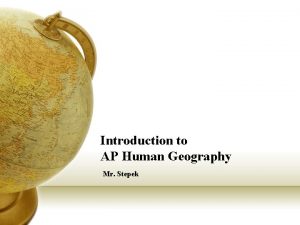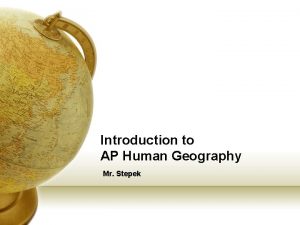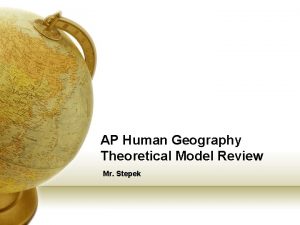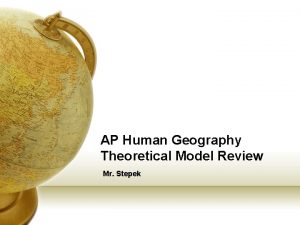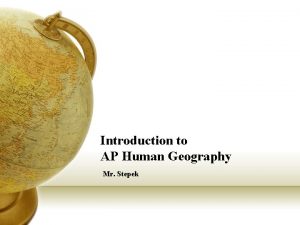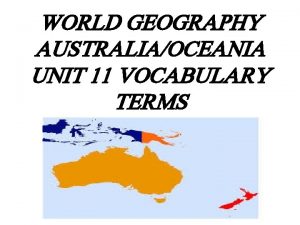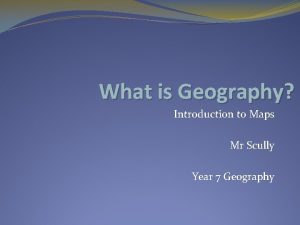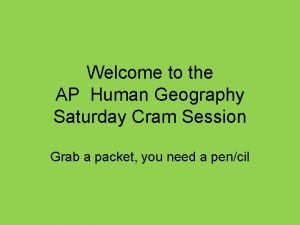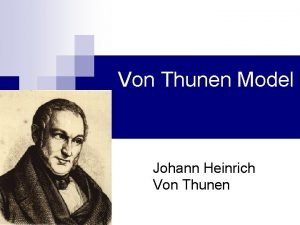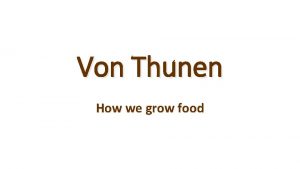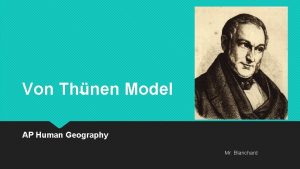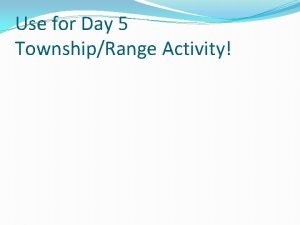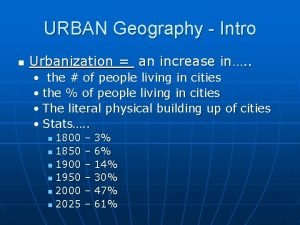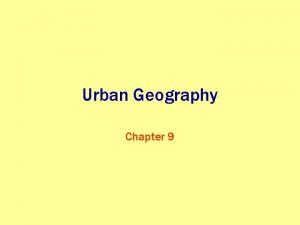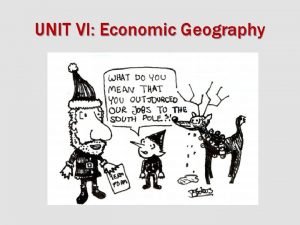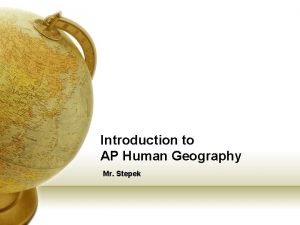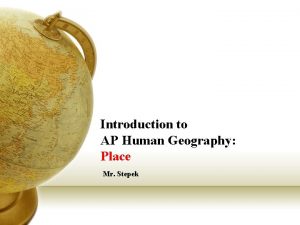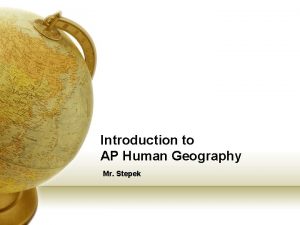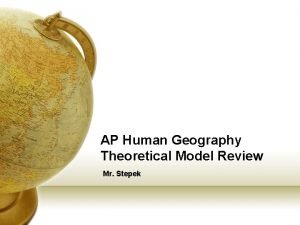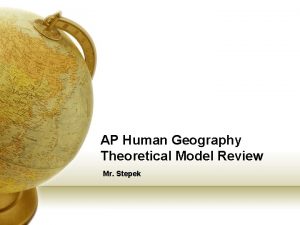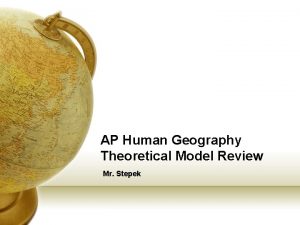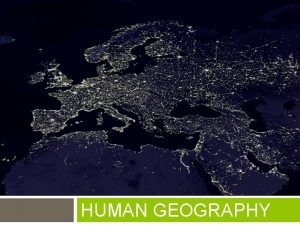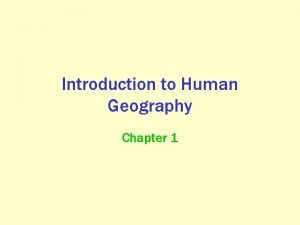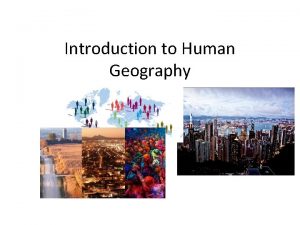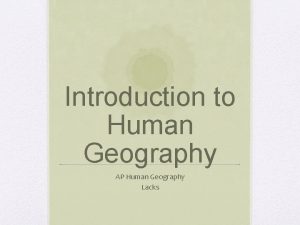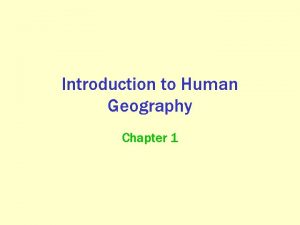Introduction to AP Human Geography Mr Stepek Introduction























- Slides: 23

Introduction to AP Human Geography Mr. Stepek

Introduction to AP Human Geography “Tools” & “Projections” and “Thematic Maps”

Geographic Technology Tools • Remote sensing • collect data with tools while physically distant from the area. • Why? • Difficult or dangerous • GPS (Global Positioning System) • uses satellites to pinpoint location, direction, velocity thru triangulation

Geographic Technology Tools (continued) • GIS (geographic info. system) • permits storage/analysis of data in layers • Ghost Map (Snow/Cholera) • https: //www. ted. com/talks/steven_j ohnson_how_the_ghost_map_helpe d_end_a_killer_disease? language=e n

“Mapping a 3 -dimensional world on a 2 dimensional surface” = Map Projections Method Goal • “Equal area” – relative sizes of landmasses are maintained, but shape is often grossly distorted. • “Conformal” – shapes of landmasses and local direction maintained while sacrificing accurate size.

Azimuthal or Planar Projections

Mercator Projection (1569)

Classic size distortion example: South America vs. Greenland

Gall-Peters Projection

Goode’s homolosine “Interrupted” projection

Robinson Projection

Goode’s Homosoline “Interrupted” All projections have some degree of distortion: size, shape, distance, or direction

Introduction to AP Human Geography “Thematic Maps”

Thematic maps tell a story! You should understand the advantages of using the different types and why Choropleth map Dot density map

Thematic Maps: dot density maps • dots indicate the # of occurrences in a given area and exact location of events • location detail may be important in analysis • Best for raw data, • NOT ratios or generalized data (averages or rates, etc. ) • Distribution on a dot density map can be described using the three properties of a distribution • This will be covered shortly

Thematic Maps: choropleth • Spatial unit is assigned color • best when shades of same color are used • darker = greater occurrence of the phenomenon being analyzed • strength • shows dominance of a trait • easily to compare spatial units • weakness • “level of aggregation” or “generalization” must be considered. • What sized spatial unit is the data displayed across? • See map above. • is it an appropriate sized unit to analyze this concept? • could give false conclusion

Thematic Maps: isoline/isopleth • Lines connect similar values • used for elevation, create contour map • ex: barometric pressure on weather maps • If data bands are assigned colors = isopleth • allows range of values within limits • excellent for showing diffusion (spread) of a phenomenon like a disease.

Thematic Types of Maps: flowline maps Shows movement of people, information, and goods between places

Types of Maps: Topographic Reflects the Earth’s physical features (terrain, elevation)

Graphs in the form of “maps”: Cartograms • Distorts size of a map units to allow comparison of data. • more of a “graph” concept than a map = graph in map form

2008 Election Results

Map legend/key • To analyze special attention MUST paid to the map legend or key, use it to identify • scale • symbols • color coding • This will help you to think about reasons for the pattern shown on the map.

Graduated symbol map Map legend/key • To analyze special attention MUST paid to the map legend or key • Identifies scale • Identifies symbols • Identifies color coding
 Graduated symbol map definition ap human geography
Graduated symbol map definition ap human geography Mr stepek ap human geo
Mr stepek ap human geo Mr stepek ap human geo
Mr stepek ap human geo Neo malthusians definition ap human geography
Neo malthusians definition ap human geography Formal region example
Formal region example Frq examples ap human geography
Frq examples ap human geography 5 themes of geography ap human geography
5 themes of geography ap human geography Proruption ap human geography
Proruption ap human geography Human development index definition ap human geography
Human development index definition ap human geography Leapfrogging ap human geography
Leapfrogging ap human geography Ap human geography chapter 11 vocab
Ap human geography chapter 11 vocab Geography lines
Geography lines Alpha beta gamma cities ap human geography
Alpha beta gamma cities ap human geography Anocracy ap human geography definition
Anocracy ap human geography definition Alfred webers least cost theory
Alfred webers least cost theory Von thunen model
Von thunen model Rectangular survey system ap human geography
Rectangular survey system ap human geography Ranching definition ap human geography
Ranching definition ap human geography Township and range ap human geography
Township and range ap human geography Bid rent theory example
Bid rent theory example Redlining ap human geography
Redlining ap human geography Central place theory assumptions
Central place theory assumptions Technopole ap human geography
Technopole ap human geography Modernization model ap human geography
Modernization model ap human geography
